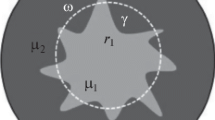Abstract
Models of the residual oil saturation distribution are proposed for linear, axisymmetric, and general flows. The steady displacing fluid flow model makes it possible to find equilibrium residual oil saturation distributions corresponding to given flow regimes by treating the porous medium with capillary-trapped oil as a medium with permeability that depends on the displacement conditions. The dynamics of the mobilized globules of the residual oil are excluded from consideration. The simulation results indicate that the residual oil saturation distribution after stimulation of the wash-out zone by means of enhanced oil recovery techniques is generally essentially nonuniform.
Similar content being viewed by others
References
N. N. Mikhailov, A. V. Dzhemesyuk, T. N. Kol’chitskaya, and N. A. Semenova,Study of the Residual Oil Saturation of Developed Reservoirs [in Russian], VNIIOENG, Moscow (1990).
N. N. Mikhailov, T. N. Kol’chitskaya, A. V. Dzhemesyuk et al.,Physico-Geological Problems of Residual Oil Saturation [in Russian], Nedra, Moscow (1993).
D. A. Efros,Investigations of Flow through Porous Inhomogeneous Systems [in Russian], Gostopizdat, Leningrad (1963).
A. M. Kuznetsov, “Scientific and methodical basis of the investigation of the influence of reservoir rock properties on the efficiency of hydrocarbon recovery,” [in Russian], Thesis for Doctorate in Technical Sciences, Moscow (1998).
A. K. Kurbanov, “Equations of motion of two-phase fluids in a porous medium,” in:Theory and Practice of Oil Recovery [in Russian], Nedra, Moscow (1968), P. 281.
V. M. Entov, V. N. Pankov, and S. V. Pan’ko,Mathematical Theory of Residual Viscoplastic Oil Traps [in Russian], Tomsk University Press, Tomsk (1989).
I. Chatzis and N. R. Morrow, “Correlation of capillary number relationships for sandstones,”SPE Journal,24, 555 (1984).
K. S. Basniev, I. N. Kochina, and V. M. Maksimov,Subsurface Hydromechanics [in Russian], Nedra, Moscow (1993).
Additional information
Moscow. Translated from Izvestiya Rossiiskoi Akademii Nauk, Mekhanika Zhidkosti i Gaza, No. 3, pp. 98–104, May–June, 2000.
Rights and permissions
About this article
Cite this article
Dzhemesyuk, A.V., Mikhailov, N.N. Hydrodynamic models of the residual oil distribution in water-flood reservoirs. Fluid Dyn 35, 393–398 (2000). https://doi.org/10.1007/BF02697752
Received:
Issue Date:
DOI: https://doi.org/10.1007/BF02697752




